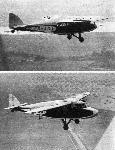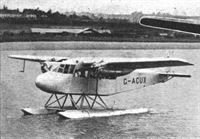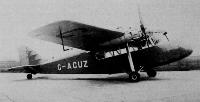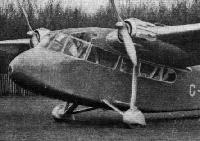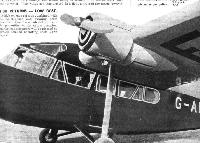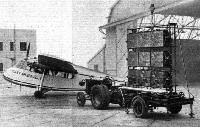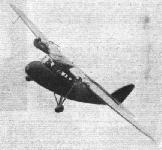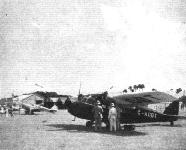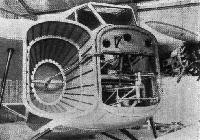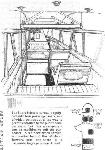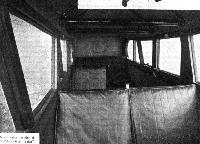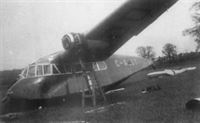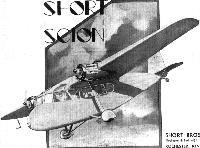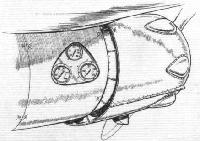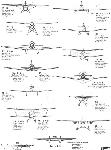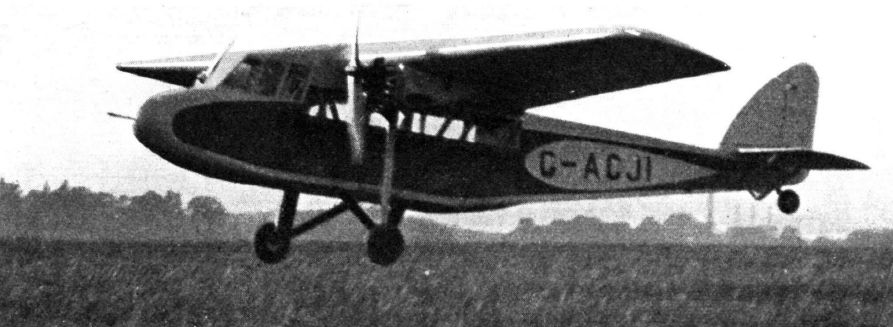
Варианты
- Short - Scion / S.16 - 1933 - Великобритания
- Short - Scion Senior / S.22 - 1935 - Великобритания
Short S.16 Scion и S.22 Scion Senior
В 1933 году компания "Short Brothers" вышла на рынок легких транспортных самолетов, предложив двухмоторный высокоплан S.16 Scion, рассчитанный на пять или шесть пассажиров и оснащенный двумя двигателями Pobjoy R мощностью 75 л. с. Первый самолет поднялся в воздух в Грейвсенде в августе 1933 года и получил сертификат летной годности в феврале 1934 года. Первая партия из четырех серийных Scion I была построена с двигателями Pobjoy Niagara I или II мощностью 85 л. с., но пятый Scion I и последняя партия из десяти Scion II получили двигатели Pobjoy Niagara III мощностью 90 л. с.
Ввиду большого объема работ по летающим лодкам Empire компания продала права на производство Scion компании "Douglas Pobjoy", построившей еще шесть самолетов.
<...>
Описание:
- Short S.16 Scion и S.22 Scion Senior
- Flight, September 1933
A NEW SHORT TRANSPORT MONOPLANE - Flight, February 1934
SHORTS' "SCION" - Flight, February 1935
THE IMPROVED SHORT "SCION" - Flight, April 1936
MODERN LIGHT AIRCRAFT REVIEW - Flight, March 1938
British light aircraft - Flight, October 1938
British Commercial Aircraft
Фотографии
-
Flight 1933-09 / Flight
Регистрационный номер: G-ACJI [7] The new Short Transport monoplane making a test flight.
-
Flight 1933-10 / Flight
Регистрационный номер: G-ACJI [7] THOROUGH flight testing to weed out any possible "snags" before going into production is the policy adopted by Short Brothers in connection with the little civil monoplane with two Pobjoy "R" engines. The above views were secured at Gravesend Aerodrome by our Chief Photographer recently when Mr. Lankester Parker was carrying out some tests. A deck fairing hap been added to the previously flat top of the fuselage behind the wing, but so far it has not been possible, owing to unfavourable weather conditions, to determine the effect of this fairing on performance, stability and trim. The tests are being continued.
-
Air-Britain Archive 1981-02
Регистрационный номер: G-ACJI [7] The prototype Short Scion G-ACJI at Gravesend early in 1934. Astute readers will notice the control tower which matches that on the cover of Archive 2/80, thus confirming the view that Gravesend was the correct location for that picture
-
Aeroplane Monthly 1989-06 / J.Stroud - Wings of Peace
Регистрационный номер: G-ACJI [7] The prototype Scion after the curved decking had been added to the rear fuselage.
-
Flight 1934-02 / Flight
Регистрационный номер: G-ACJI [7] 36 H.P. PER PAYING PASSENGER: The Short "Scion" with its low power per passenger is a most economical aeroplane.
The prototype Short Scion, G-ACJI, made its maiden flight from Gravesend in August 18, 1933. -
Flight 1934-08 / Flight
A FORCED LANDING WITH REASON: Just in case there may be some pilots who underrate the weather with which our English pilots have to contend, we publish this photograph of a Short "Scion" taken by Mr. A. Irwin just after he had decided that discretion was the better part of valour. The black clouds behind the machine are right down on the ground and completely block the way to Aberdeen, a journey which on this occasion took seven hours instead of the usual three or so.
-
Air Enthusiast 2000-11 / G.Warner - Founding Fathers (2)
Регистрационный номер: G-ACUV [3] Aberdeen Airways initially used Short S.16 Scion G-ACUV.
-
Flight 1934-07 / Flight
Регистрационный номер: G-ACUV [3] EFFICIENCY: With two Pobjoy "Niagara" engines of 90 h.p. each, the Short "Scion" carries pilot and five passengers at a cruising speed of 100 m.p.h.
-
Flight 1934-11 / Flight
Регистрационный номер: G-ACUW -
Aeroplane Monthly 1989-06 / J.Stroud - Wings of Peace
Регистрационный номер: G-ACUX [4], VH-UUP [4] The Scion I G-ACUX was built as a seaplane, operated in New Guinea as a landplane, and may still exist in Australia.
-
Flight 1939-04 / Flight
Регистрационный номер: G-ACUX [4], VH-UUP [4] Interchangeable wheel and float undercarriages gave the popular little Scion a wide field of application.
-
Flight 1935-03 / Flight
Регистрационный номер: G-ACUX [4], VH-UUP [4] GOLD RUSH: This particular Short "Scion," fitted with floats, is to be used for gold survey in Papua.
-
Aeroplane Monthly 1989-06 / J.Stroud - Wings of Peace
Регистрационный номер: G-ACUZ [6] G-ACUZ was the fifth production aircraft and the first Scion II. The wheel spats were soon removed.
-
Мировая Авиация 234
Регистрационный номер: G-ACUZ [6] G-ACUZ - первый из 10 самолетов Scion II, которые оснащались парой двигателей Niagara III. Эти самолеты развивали максимальную скорость 206 км/ч.
-
Air Pictorial 1956-03 / ??? - The Short Scion Junior /A 1/72 scale plan/
Регистрационный номер: G-ACUZ [6] -
Aeroplane Monthly 1985-06 / N.Ewart - When flying was still an adventure (3)
Регистрационный номер: G-ADDP [2], X9374 [2] The Short Scion G-ADDP, flown by the author for Air Touring at Gatwick. The Scion was powered by two 90 h.p. Pobjoy Niagara engines. G-ADDP was scrapped in April 1941 after RAF impressment as X9374 a year earlier.
-
Flight 1936-04 / Flight
Регистрационный номер: G-ADDT [9] -
Flight 1937-01 / Flight
The Scion is of Short design and Pobjoy manufacture and is powered with two Niagara radials.
-
Aeroplane Monthly 1984-07 / J.Viner - The great Flea race
Регистрационный номер: G-ACUZ [6], G-ADDV THE CROWD that came to see the Poux race at Ramsgate on Saturday - and stayed to joy-ride in the airport's Short Scions. Mr. Whitney Straight, incidentally, is having some fine hangars and club buildings erected.
The scene at Ramsgate Airport on August 3, 1936. In the foreground is Ramsgate Airport's Short Scion G-ADDV; behind that is another Scion, G-ACUZ, Monospar ST-6 G-ACGI, a Swallow, Aeronca C-3, a row of Fleas and the Cierva C.30 autogyro.Другие самолёты на фотографии: Aeronca C - США - 1929British Klemm L.25 Swallow - Великобритания - 1933Cierva/Avro C.30A / Rota - Великобритания - 1932General Aircraft Monospar ST-4 - ST-12 - Великобритания - 1932Mignet Pou-de-Ciel / HM-14 - Франция - 1932
-
Flight 1936-11 / Flight Advertisements
Регистрационный номер: G-AEJN -
Aeroplane Monthly 1985-07 / Personal album
Регистрационный номер: G-AEZF [3] Short Scion G-AEZF seen at Heston where it later became the subject of a court order. The bailiff's men took one of the wheels away to prevent the aircraft's removal. The Scion was subsequently sold and was later withdrawn from use at Exeter in May 1954.
-
Aeroplane Monthly 1989-06 / J.Stroud - Wings of Peace
Регистрационный номер: VH-UVQ The Adelaide Airways Scion II VH-UVQ before delivery. It passed to Australian National Airways in July 1936 and was withdrawn from use in 1939.
-
Flight 1937-12 / Flight
Регистрационный номер: VQ-PAB ECONOMICAL TRANSPORT: One of the two five-passenger Pobjoy Scions used by Palestine Airways on services linking the towns of Tel Aviv, Haifa, Jerusalem and Lydda. The chief pilot of the Company is Capt. Andrews, who was previously in the service of Imperial Airways. The new engine cowlings and the slightly modified pilot's window arrangements are worth noting.
-
Flight 1935-02 / Flight
The roomy cabin of the new "Scion"; its proximity to the ground makes entrance and egress very simple for passengers.
-
Flight 1936-01 / Flight
A.G.E.C floodlight, mounted as a mobile unit, in use at the Brighton, Hove and Worthing municipal airport.
-
Flight 1935-02 / Flight
Регистрационный номер: G-ACUZ [6] This flying picture shows how the Pobjoy "Niagara" engines have been cleanly faired into the wing and indicates the excellent outlook which the new nose design allows the pilot.
-
Flight 1936-05 / Flight Advertisements
Регистрационный номер: G-ADDT [9] -
Flight 1936-04 / Flight Advertisements
Регистрационный номер: G-ADDT [9] -
Flight 1935-05 / Flight
Регистрационный номер: G-ACUZ [6] NEXT OF KIN: The modified Short "Scion" which has just been delivered to Southend Flying Services, Ltd. Changes in the shape of the nose, in which a landing light is fitted, and the fact that the engine nacelles are now in the centre line of the wing section account for the improved performance.
-
Aeroplane Monthly 1985-06 / N.Ewart - When flying was still an adventure (3)
Регистрационный номер: G-ADDP [2], X9374 [2] The Short Scion G-ADDP, flown by the author for Air Touring at Gatwick. The Scion was powered by two 90 h.p. Pobjoy Niagara engines. G-ADDP was scrapped in April 1941 after RAF impressment as X9374 a year earlier.
-
Flight 1938-04 / Flight
The Pobjoy-powered Scion is available as a landplane or on floats.
-
Aeroplane Monthly 1989-06 / J.Stroud - Wings of Peace
This view shows the clean lines of the Scion II. Note the higher position of the Pobjoy engines compared with that of the Scion I.
-
Flight 1936-11 / Flight
With a pair of 90 h.p. Pobjoy Niagara' IIIs the Pobjoy Scion cruises at 115 m.p.h. with a disposable load of 1,000 lb.
-
Aeroplane Monthly 1989-06 / J.Stroud - Wings of Peace
Регистрационный номер: G-ADDN Southend-on-Sea Flying Service's Scion II G-ADDN.
-
Flight 1935-12 / Flight
A Short Scion
-
Flight 1937-06 / Flight
Finale: Herr Wendel (inset) winds up his demonstration with the Bucker Jungmeister with a high-speed inverted passage across the aerodrome at zero altitude. When this picture was taken he was climbing to avoid the Short Scion on the left; on his previous passage the Bucker's tail fin positively stroked the grass - to the terrified joy of the onlookers.
Другие самолёты на фотографии: Bucker Bu.133 Jungmeister - Германия - 1935
-
Flight 1938-03 / Flight
The view from the clubhouse, opened last summer, of the Thanet Aero Club, Ramsgate.
-
Flight 1936-04 / Flight
Competing machines in the Viceroy's Cup Race lined up on the aerodrome at Bombay. The Scion is fifth in the line.
-
Flight 1936-04 / Flight
Регистрационный номер: G-ADDT [9] The machine being refuelled at Bombay during the race.
-
Flight 1935-06 / Flight
YOUNG ENTHUSIASTS, members of the Skybird League, who recently visited the new aerodrome at Southend-on-Sea as guests tf the Southend Flying Club. They are seen standing by the Club's Short "Scion," in which Mr. A. M. Glover (Chief Instructor) gave many of them flights.
-
Aeroplane Monthly 1977-06 / News Spotlight
Регистрационный номер: VH-UUP [4], G-ACUX [4] Also moved into the Museum, on March 21, 1977, was the Short Scion VH-UUP, which will eventually be restored in its original marks as G-ACUX.
-
Flight 1933-10 / Flight
ACCESSIBILITY: The nose of the new Short monoplane (two Pobjoy engines) is hinged so as to allow ready inspection and adjustment of the controls, instruments, etc. The machine is at present being thoroughly tested by Mr. Lankester Parker before deciding on production. That the machine is efficient is shown by the fact that, carrying three occupants for each Pobjoy engine, the top speed is in the neighbourhood of 115 m.p.h.
-
Flight 1934-02 / Flight
OPEN SESAME: For ease of maintenance the nose of the "Scion" can easily be swung open. It also carries the air bottle for the Dunlop wheel brakes.
-
Flight 1936-04 / Flight
The present Pobjoy cowling is of long chord and incorporates "helmets" for the cylinders. This installation is of a Niagara in a Short Scion
-
Air-Britain Archive 1982-02
Регистрационный номер: G-ACJI [7] The Yorkshire Aeroplane Club's Gipsy Moth G-AAJW (1135) at Yeadon during 1937. Visible in the hangar is Short Scion G-ACJI.
Другие самолёты на фотографии: De Havilland Gipsy Moth / Moth X - Великобритания - 1928
-
Flight 1936-04 / Flight
H.H. The Maharajah of Jodhpur trying out the Scion with his personal pilot, Flt. Lt. Godwin, at the controls.
-
Flight 1936-04 / Flight
The Short Scion is normally equipped with four passenger seats, one of which swings out of the way to permit entrance to the pilot' s compartment, but this arrangement can be modified to suit the purchaser. A radio set, when carried, is mounted behind the left-hand forward seat and there is a separate luggage compartment.
-
Flight 1936-05 / Flight Advertisements
Roomy cabin interior of the Pobjoy-Short "Scion"
-
Aeroplane Monthly 1993-08 / M.Oakey - Grapevine
Регистрационный номер: G-AEZF [3] The UK’s sole surviving Short S.16 Scion G-AEZF needs a new home. Southend milkman Ray Jackson has been rebuilding it with the help of retired engineer George Hurst in a neighbour’s garage - but now the neighbour wants his garage back. Jackson is appealing to anyone in Essex who can provide space to house the 31ft fuselage, and to enable him to continue the rebuild - which is being tackled using photographs and sketches, since no manufacturer’s drawings have been found.
-
Aeroplane Monthly 1996-12 / M.Oakey - Vintage news
Регистрационный номер: G-AEZF [3] Also at Redhill, Ray Jackson is restoring 1937 Short Scion G-AEZF for static display at Croydon Airport. He is seeking seats and other parts for the twin Pobjoy Niagara-engined airliner - contact him via Acebell on 01737 822212.
-
Aeroplane Monthly 1981-07 / Personal album
Регистрационный номер: G-ADDT [9] The Scion G-ADDT during an earlier mishap, probably at Coventry, though on this occasion the aircraft was taken back to Brooklands and repaired.
-
Air-Britain Archive 1987-03
Регистрационный номер: G-ADDT [9] Short Scion G-ADDT with "T. Cameron Black" on the fuselage and "Gaumont British" on the tail. Where and when was this taken and what is the significance of these inscriptions?
Operated by Tom Campbell Black's flying circus, the Scion c/n S790 was also used for collection of cinema newsreels, hence the Gaumont British News titles. A head-on view shows starboard u/c leg broken but little other damage. Location was Westwood Heath aerodrome and the Scion was dismantled and taken to Brooklands for repair. Date was 10.5.36, shortly before G-ADDT was finally written off at Porthcawl on 26.7.36. -
Aeroplane Monthly 1981-07 / Personal album
Регистрационный номер: G-ADDT [9] The final demise of Short Scion G-ADDT. The crash took place at Porthcawl in South Wales on July 26, 1936. Ron Paine can be seen on the extreme left.
-
Aeroplane Monthly 1981-07 / Personal album
Регистрационный номер: G-ADDT [9] The final demise of Short Scion G-ADDT. The crash took place at Porthcawl in South Wales on July 26, 1936. Scion ’DT was painted green with cream letters and the words Gaumont British News can be seen painted on the fin and rudder.
-
Aeroplane Monthly 1989-06 / J.Stroud - Wings of Peace
Регистрационный номер: G-ACUV [3] KEITH WOODCOCK'S painting shows Aberdeen Airways' Short Scion G-ACUV in its original livery.
-
Flight 1935-01 / Flight Advertisements
Регистрационный номер: G-ACJI [7] "SCION" This machine has a take-off run of 120 yards - landing run 100 yards Fitted with two Pobjoy Niagara Engines which use less petrol per h.p. than any other air-cooled engine, thereby enabling this machine to give maximum mileage for minimum cost.
-
Flight 1934-07 / Flight
The rev. counter, oil-temperature and oil-pressure gauges, as seen from the cabin of the Short "Scion."
-
Flight 1934-10 / Flight
Другие самолёты на фотографии: Bellanca 28 Flash - США - 1934De Havilland Comet / D.H.88 - Великобритания - 1934De Havilland Fox Moth / D.H.83 - Великобритания - 1932De Havilland Leopard Moth / D.H.85 - Великобритания - 1933Fairey Fox - Великобритания - 1925Harkness & Hillier All Australian - Австралия - 1934Lockheed Sirius / Altair 8 - США - 1929Lockheed Vega - США - 1927Miles Falcon M.3 / Hawcon M.6 - Великобритания - 1934Monocoupe 90 / 110 / 145 - США - 1930Northrop Delta - США - 1933Percival Gull - Великобритания - 1932
- Фотографии

